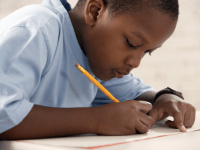New Class Roles: Building Environments of Cooperation
Create empathy and self-esteem by assigning in-class roles and responsibilities that can help students bring out the best in themselves and each other.
Your content has been saved!
Go to My Saved Content.We see students survive every day. We ourselves survive every day -- a class, a test, a conflict, a relationship, and a challenge. Yet surviving is very different than thriving! Many students that we see daily bring a degree of their stress into our classrooms. Thankfully, many of them also have supports in their lives that allow them to manage this stress in a productive manner.
Our most difficult students, however, are not as lucky. They live in a state of chronic toxic stress, which changes the brain, literally placing it in a survival mode. If the brain is in chronic toxic stress, its creative, resourceful, and cooperative higher-level thought processes are compromised because of emotions and thoughts that feel unsafe, unfamiliar, and threatening. We walk into our classrooms feeling disconnected from one another, the learning, and our purpose. When we feel shame, anger, sadness, or any negative emotion over an extended period, our brains begin creating neural pathways that ignite habits of feelings in response to the thoughts that call forth these emotions. This self-centered focus on survival greatly inhibits learning. Stressed brains resist new information.
Our classrooms can become "holding environments" where children and adolescents begin to feel good about themselves through serving one another, increasing their sense of purpose and capability, which increases self-esteem and positive emotion.
How do we establish bonds based on commonalities rather than differences in our schools and classrooms, places where feelings of mastery, autonomy, and purpose intimately impact the learning and instructional process? I suggest that we create classroom responsibilities, tangible roles, and cooperative tasks that position students and teachers for success.
6 Classroom Professions
Last week as I was driving to one of our large, diverse public elementary schools to speak with teachers about connection, my mind went to a different realm of classroom structure and function. I began to think differently about what bonding and empathy look like in our classrooms. Traditionally, we give students classroom responsibilities with different jobs (paper passer, line leader, errand runner, etc.), but what if we built relationships and trust through leadership and caregiving roles? These roles and responsibilities call us to explore an emotional climate in our classrooms that would breed service and compassion. When we engage with one another, feeling the power of our compassion and service, the neural circuitry in the brain shifts, and our "reward system" of dopamine and serotonin sharpens our focus, emotional regulation, and engagement. We prime our brains for deepened learning and social connection.
The following "classroom professions" can change as needed and are presented as guidelines and ideas for exploring and adapting at all grade levels. These class responsibilities and roles are vitally important in secondary education as well, as we are providing opportunities for our students to experience co-leadership roles rather than being passive recipients of rules, lectures, and dispensed knowledge.
1. Giver
This student's responsibility is to give encouragement, affirmation, and acts of kindness throughout the day. The giver may use post-its, create signs, deliver spoken messages, or communicate hopefulness by any means.
2. Storyteller
Storytelling could take many forms, such as seeking books to share, or integrating vocabulary or content words into a story. Younger students might create a story with pictures. Older students could work with journal stories, writing, sharing, turning them into screenplays, or submitting them for publication. Your storyteller may develop an iMovie or blog for the class. He or she could create a class story with classmate's names and school projects, or weave any content into this context for learning standards or subject matter. The brain adheres to stories!
3. Noticer
This job is to notice what is going well and right. It is the antithesis to tattling or snitching.
4. Kindness Keeper
This student would record all of the kind acts performed throughout the day or week. The kindness keeper reflects on these kindnesses and shares with the class periodically.
5. Resource Manager
The resource manager suggests ideas, resources, or ways to solve a problem or locate information, either academically or behaviorally.
6. Collaborator
This is one role that could be assigned for acting outside the classroom. Maybe there is another teacher, staff member, or student in the school that needs an emotional, social, or cognitive boost? At department and all-staff meetings, the collaborator would share ideas that promote student-to-teacher or student-to-student relationships, or bridging in- and out-group biases that happen when we only perceive differences.
Enjoy these new roles while collecting the perceptual data through surveys, observations, and feedback from one another as the roles change and modify.
Understanding and Empathy
Creating emotional connections inspires a sense of belonging and service, elevating feelings of purpose, identity, and positive emotion. When we model for one another what we desire to see with regard to behavior and engagement, the social, emotional, and academic learning deepen and are remembered for the long term.
The Cleveland Clinic has produced a video on empathy which helps us to better understand the life and feelings of another. Our fifth grade students in Washington Township are creating a similar video in the school. They will record students in the halls, classrooms, and other areas, and place "thought bubbles" depicting what these children might be thinking or feeling. They will share their documentary with the school and create discussion groups in different grade levels.
- What roles could you develop in your classrooms that are MAPS for creating student mastery, autonomy, and purpose?
- How can we model service through our instruction, assessments, and the culture (emotional and physical design) in our classrooms and schools?
- What are some small "pay it forward" tasks or initiatives that our students could create for the entire school?
